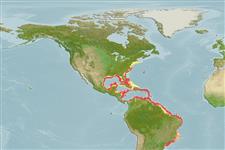Environment: milieu / climate zone / depth range / distribution range
Ecologia
marinhas demersal; intervalo de profundidade 30 - 525 m (Ref. 5222), usually 100 - 200 m (Ref. 5222). Subtropical; 41°N - 27°S, 98°W - 34°W (Ref. 5222)
Western Atlantic: Canada (Ref. 5951) to Massachusetts, USA to southern Brazil, including the Gulf of Mexico and the Caribbean.
Length at first maturity / Tamanho / Peso / Idade
Maturity: Lm 54.0, range 47 - ? cm
Max length : 122 cm TL macho/indeterminado; (Ref. 26340); common length : 60.0 cm TL macho/indeterminado; (Ref. 5217); peso máx. Publicado: 30.0 kg (Ref. 5222); Idade máx. registada: 27 anos (Ref. 3090)
Espinhos dorsais (total) : 11; Raios dorsais moles (total) : 13 - 15; Espinhos anais: 3; Raios anais moles: 9. Distinguished by the following characteristics: Dark margin on spiny dorsal fin and dark saddle on caudal peduncle that extends below lateral line (Ref. 26938); juveniles with pale yellow caudal and pectoral fins; black saddle blotch on the caudal peduncle reaching below lateral line; depth of body contained 2.4-2.8 times in SL; head length 2.2-2.4 times in SL; convex interorbital area, width less than or subequal to eye diameter; enlarged serrae at angle of preopercle; distinctly convex upper edge of operculum; posterior nostrils 2-5 times larger than anterior nostrils (Ref. 89707).
Adults occur well offshore on rocky bottoms. Juveniles may be found inshore and are often reported from the northeastern coast of the U.S (Ref. 89707). Adults feed on fishes, gastropods, cephalopods, and brachyuran crustaceans (Ref. 5222). Valuable commercial food fish (Ref. 26938).
Life cycle and mating behavior
Maturidade | Reprodução | Desova | Ovos | Fecundidade | Larvas
The size (76.7-109 cm) and age (8-29 yr) of 97 male specimens and the capture of two specimens undergoing sex change provided conclusive
evidence that snowy grouper are protogynous hermaphrodites (Ref. 45886).
Craig, M.T. and P.A. Hastings, 2007. A molecular phylogeny of the groupers of the subfamily Epinephelinae (Serranidae) with revised classification of the epinephelini. Ichthyol. Res. 54:1-17. (Ref. 83414)
Categoria na Lista Vermelha da IUCN (Ref. 130435: Version 2024-1)
Ameaça para o homem
Harmless
Utilização humana
Pescarias: espécies comerciais; peixe desportivo: sim
Ferramentas
Relatórios especiais
Descarregue XML
Fontes da internet
Estimates based on models
Preferred temperature (Ref.
123201): 14.8 - 23.7, mean 19.5 °C (based on 93 cells).
Phylogenetic diversity index (Ref.
82804): PD
50 = 0.5001 [Uniqueness, from 0.5 = low to 2.0 = high].
Bayesian length-weight: a=0.01585 (0.01219 - 0.02060), b=3.04 (3.01 - 3.07), in cm total length, based on LWR estimates for this species (Ref.
93245).
Nível Trófico (Ref.
69278): 4.0 ±0.58 se; based on food items.
Resiliência (Ref.
120179): Baixo, tempo mínimo de duplicação da população 4,5 - 14 anos (K=0.07-0.09; tmax=27).
Prior r = 0.17, 95% CL = 0.11 - 0.25, Based on 1 full stock assessment.
Fishing Vulnerability (Ref.
59153): High vulnerability (64 of 100).
Climate Vulnerability (Ref.
125649): Moderate to high vulnerability (51 of 100).
Nutrients (Ref.
124155): Calcium = 34.8 [15.4, 66.9] mg/100g; Iron = 0.74 [0.39, 1.39] mg/100g; Protein = 18.6 [16.8, 20.3] %; Omega3 = 0.382 [0.237, 0.648] g/100g; Selenium = 49.2 [25.6, 92.7] μg/100g; VitaminA = 9.2 [3.1, 31.1] μg/100g; Zinc = 0.511 [0.367, 0.752] mg/100g (wet weight);
